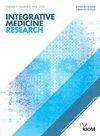韩西药在工业事故后的使用:一个障碍模型分析
IF 3
4区 医学
Q2 INTEGRATIVE & COMPLEMENTARY MEDICINE
引用次数: 0
摘要
▽使用韩医的受伤劳动者从2013年的752人增加到2023年的10273人,但这一趋势仍未得到充分的研究。本横断面研究调查了受伤工人中KM和西医(WM)使用的频率和因素。方法对2018年和2023年工人赔偿保险小组研究(PSWCI)的6,985名参与者的数据进行分析。障碍模型评估门诊访问:使用概率的逻辑回归和访问强度的负二项回归。人口统计学、社会经济和临床因素被纳入协变量。结果6985名参与者中,182人使用KM, 5970人使用WM, 833人没有门诊就诊。有私人医疗保险者和下肢损伤者在KM和WM利用上均表现出更高的总边际效应(TME)。KM的使用表明,女性和职业病患者的TMEs较高,但其他身体部位受伤的TMEs较低。较高的WM使用率与残疾、高血压、慢性病和长期康复的工人有关,而2023年队列、高等教育和收入、酒精消费和再就业与较低的WM使用率有关。结论2018年至2023年,调整后的KM利用率保持不变,而WM访问量下降。KM的使用与女性和患职业病呈正相关。就诊次数往往随着医疗严重程度的提高而增加,但随着社会经济条件的改善而减少。尽管如此,总KM索赔在WCI下的上升表明对保守的,缓解疼痛的肌肉骨骼护理的需求不断增长。本文章由计算机程序翻译,如有差异,请以英文原文为准。
Traditional Korean and Western medicine use after industrial accidents: A hurdle model analysis
Background
The number of injured workers using Traditional Korean Medicine (KM) soared from 752 in 2013 to 10,273 in 2023, yet this trend remains underexplored. This cross-sectional study examined the frequency and factors linked to KM and Western Medicine (WM) use among injured workers.
Methods
Data from 6,985 participants in the 2018 and 2023 waves of the Panel Study of Workers’ Compensation Insurance (PSWCI) were analyzed. A hurdle model assessed outpatient visits: logistic regression for the probability of use and negative binomial regression for visit intensity. Demographic, socioeconomic, and clinical factors were included as covariates.
Results
Of 6,985 participants, 182 used KM, 5,970 used WM, and 833 reported no outpatient visits. Having private medical insurance and lower limb injuries showed higher Total Marginal Effects (TME) of both KM and WM utilization. KM use showed higher TMEs among females and those with occupational diseases but lower TMEs for injuries to other body regions. Higher WM utilization was linked to workers with disabilities, hypertension, chronic conditions, and extended rehabilitation, while the 2023 cohort, higher education and income, alcohol consumption, and re-employment were linked to lower WM use.
Conclusions
Between 2018 and 2023, adjusted KM utilization remained unchanged, whereas WM visits declined. KM use was positively linked to being female and having occupational diseases. WM visits tended to rise with greater medical severity yet decreased as socioeconomic conditions improved. Still, the rise in total KM claims under WCI indicates a growing demand for conservative, pain-relieving musculoskeletal care.
求助全文
通过发布文献求助,成功后即可免费获取论文全文。
去求助
来源期刊

Integrative Medicine Research
Medicine-Complementary and Alternative Medicine
CiteScore
6.50
自引率
2.90%
发文量
65
审稿时长
12 weeks
期刊介绍:
Integrative Medicine Research (IMR) is a quarterly, peer-reviewed journal focused on scientific research for integrative medicine including traditional medicine (emphasis on acupuncture and herbal medicine), complementary and alternative medicine, and systems medicine. The journal includes papers on basic research, clinical research, methodology, theory, computational analysis and modelling, topical reviews, medical history, education and policy based on physiology, pathology, diagnosis and the systems approach in the field of integrative medicine.
 求助内容:
求助内容: 应助结果提醒方式:
应助结果提醒方式:


